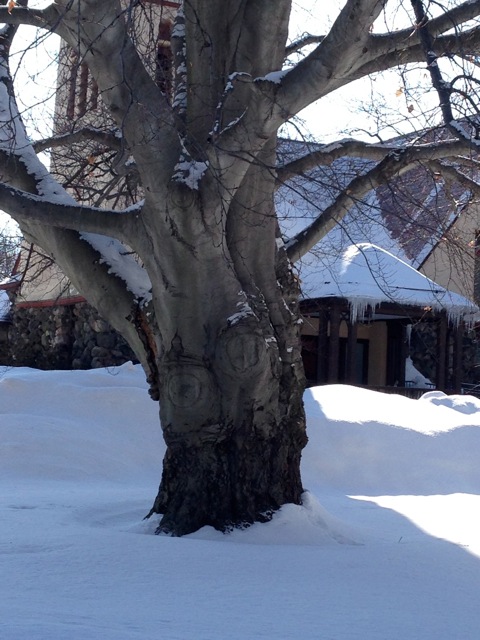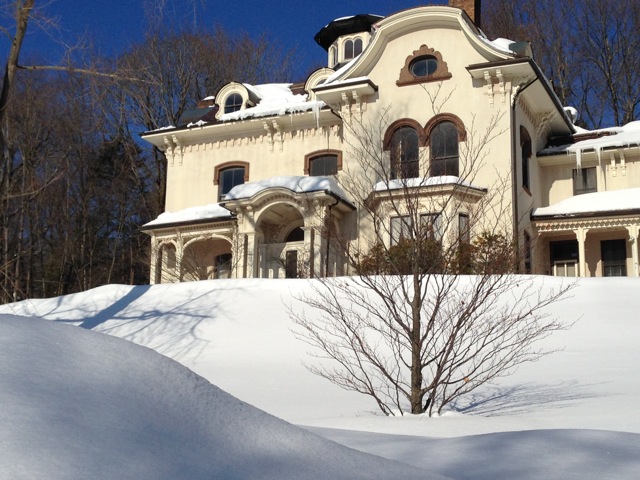By Elizabeth Gourley
“There is no finer specimen tree; so beautiful that it overwhelms one at first glance,” states Michael Dirr, University of Georgia professor and author of Manual of Woody Landscape Plants, on the merits of the European beech (Fagus sylvatica). One of the most striking cultivars of European beech is the copper beech (Fagus sylvatica ‘Cuprea’). A lovely specimen can be found in the small park adjacent to The First Church in Belmont Unitarian Universalist where Concord Avenue and Common Street intersect. This majestic tree has been overseeing our comings and goings for over 150 years. Tom Walsh, Belmont’s tree warden, estimates this tree has most likely been in this location since the church was built in the 1850s.
The copper beech is one of 45 cultivars that have been developed in both the wild and under cultivation from the European beech, unlike the American beech (Fagus grandiflora), which has no cultivars. Although they are not fast growing, these trees reach sizes of 60’ high with a 45’ spread, and can reach heights of 100’ given the right growing conditions. Oval in character when young, these trees mature to be densely pyramidal to oval to round with branching close to the ground casting dark shade in the summer. Alternately, beech can grow close together in tight groves or be trained into a clipped hedge. Their muscular trunks have smooth light grey bark, which is famous for being carved with initials.
These long-lived trees provide beauty throughout the year. The leaves open in spring as deep black-red then gradually turn to purple-green in summer. In the fall, leaves turn russet and/or bronze and sometimes persist throughout winter. Bud break tends to be late, occurring in May. The purple color leaf is a rare spontaneous mutation. The pigment anthocyanin is highly concentrated within the leaves giving the tree its unusual color. This pigment absorbs green wavelengths of light from chlorophyll and reflects red and blue wavelengths, making the leaves appear purple or copper colored.
The remains of the original European beech species have been found in Neolithic and pre-glacial deposits in England. The first authenticated sighting of the copper beech by horticulturalist in the wild was in the Hanleiter Forest in Germany near Thuringia before 1772.
The copper beech was not introduced into the United States until the early 1800s. Prior to that time, American settlers focused their landscape energies on raising plants that produced food. During the 19th century, the copper beech was the most used beech in gardens, parks, and estates in the United States. In 1807, Thomas Jefferson was drawn to the tree and tried several times to grow “purple beeches” at Monticello. He finally found success after a few seasons and some of his original trees survived into the 1970s.
Belmont’s Ruth Foster wrote a column on her horticulture website, Mothersgarden.net, about two historic copper beech trees which stood in front of the Belmont Woman’s Club. These trees were pictured in Winslow Homer’s “Croquet on the Lawn” painting dating to 1866. Efforts were made in 2012 by the Belmont Woman’s Club teaming with the Belmont Land Trust to preserve these trees. The curator from Mount Auburn Cemetery’s plant collection was brought in to advise. They cautioned against growing lawn under the beech canopies. Instead, they recommended that a layer of decomposed bark mulch be placed under the tree canopies to encourage and support micro-organisms in the soil.
Mulch not only supports the health of the soil, it also helps minimize soil compaction around the base of trees by distributing weight. Beech tree feeder roots (and most all trees) are shallow growing, often located within the top 18” of soil and extending well beyond the tree’s canopy above. It is, therefore, important to avoid compacting this soil so that water, air, and nutrients can reach the roots and support the tree. Even regular foot traffic can compact some soils to such an extent that roots can no longer function properly, causing a tree’s health to slowly decline.
Unfortunately, these remedial efforts did not preserve these two trees. Thankfully, the Belmont Woman’s Club has since planted two new copper beech trees on their grounds to carry on the legacy of these historic trees. Given proper and consistent maintenance and care throughout its life, the copper beech that has captivated American gardeners and artists for hundreds of years will continue to grace us with its unique beauty.
Elizabeth Gourley is a landscape architect and principal of Elizabeth Gourley Design, LLC in Belmont.




Sorry, the comment form is closed at this time.